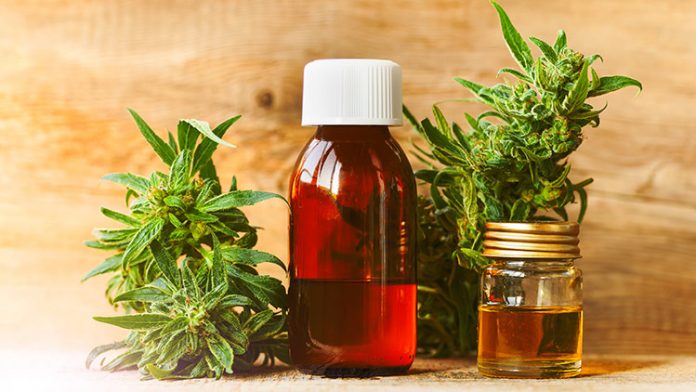Suddenly, cannabidiol (CBD) oil seems to be everywhere. People are dropping it into their nighttime tea, swallowing capsules, and loading it into their vape pens, claiming it relieves depression, masks chronic pain, and helps them sleep deeper. And although CBD oil is often derived from marijuana plants, it won’t get you high—and it’s not just potheads who are partaking.
But what is CBD oil, exactly? CBD oil is typically extracted from the resin glands on cannabis (marijuana) buds and flowers. It can also be extracted from hemp, which is an industrial, fibrous form of cannabis that has small buds and a tetrahydrocannabinol, or THC, concentration of 0.3% or less (THC is the chemical compound that’s responsible for making people high). It’s usually diluted with another type of oil, like MCT oil.
So, what’s the deal with CBD oil?
No, CBD oil really won’t get you stoned
There are more than 80 active cannabinoid chemicals in marijuana, and their effects on us stem from their interactions with specific receptors in our bodies. THC is the main psychoactive cannabinoid in the plant, and it produces intoxication and euphoria by interacting with CB1 receptors in the brain. CBD’s interaction with those same receptors is 100 times weaker than THC’s, and when it binds to them, it doesn’t alter our thoughts or perceptions in the same way.
That said, mislabeled products may have significant levels of THC—more on that below.
The legality of CBD oil depends on where you live
CBD oil is legal in the 29 states where medicinal and/or recreational marijuana is legal. Seventeen additional states have CBD-specific laws on the books: Alabama, Georgia, Indiana, Iowa, Kentucky, Mississippi, Missouri, North Carolina, Oklahoma, South Carolina, South Dakota, Tennessee, Texas, Utah, Virginia, Wisconsin, and Wyoming. Each of those states has unique restrictions on THC levels and use cases (in Missouri, for instance, it can only be used to treat epilepsy).
Research shows CBD oil may actually have health benefits
The FDA is reviewing a New Drug Application (NDA) for Epidiolex, a pharmaceutical-grade CBD product used in the treatment of seizures associated with Lennox-Gastaut syndrome and Dravet syndrome, two rare conditions of childhood-onset epilepsy.
Additionally, animal studies and anecdotal evidence suggest CBD oil has potential as a treatment for everything from anxiety and substance abuse disorders to chronic pain and diseases of the central nervous system. Two recent clinical studies—one published in The New England Journal of Medicine, the other published in The Lancet—demonstrated that it could be effective in reducing certain types of seizures.
That said, CBD oil research is limited. In the United States, cannabidiol is classified as a Schedule 1 drug (with no currently accepted medical use and a high potential for abuse), so the government requires extensive documentation from researchers interested in studying it and subjects them to extensive regulations.
What you see isn’t always what you get—CBD oil is often mislabeled
“CBD oil” is now marketed in everything from drops, capsules, syrups and teas to lotions and creams. The FDA has yet to approve any CBD products for any purpose,
which means that their production, labeling, and distribution aren’t subject to federal regulation.
A study published last year in JAMA found that more than two thirds of CBD products sold online contained either higher or lower concentrations of the substance than their labels indicated—and that some of them contained significant levels of THC, too.
“The safety and reliability of currently available CBD products depends somewhat on the states where they are produced,” says Timothy E. Welty, PharmD FCCP BCPS, professor and chair of the department of clinical sciences in the College of Pharmacy and Health Sciences at Drake University in Iowa and co-author of a 2014 review and opinion article on CBD in Epilepsy Currents.
“Some states, like Minnesota or Iowa, have state-regulated CBD production,” Welty explains. “In these states, products are tested for purity, content, and strength, so there is some reliability in [them]. In other states where production is not regulated, there is no way to know for certain what CBD products contain. Studies have shown that these products can contain impurities, pesticides, fungus, or not the amount of CBD that is on the label.”
CBD side effects can be crazy
Last year, a preliminary report from the World Health Organization (WHO) stated that “no public health problems…have been associated with the use of pure CBD,” and that it hasn’t shown potential for dependence or abuse. That said, it has been associated with side effects: In the NEJM and Lancet studies, “the most common side effects were nausea, vomiting, diarrhea, and bloating,” Welty says. “However, about 10% of patients showed changes in liver function that could have indicated toxicity. About 3% of patients in the studies had to discontinue CBD due to possible liver damage.” Furthermore, “There are definite drug interactions with CBD and other common medications. Some of these interactions could result in toxicity or serious side effects of the other drugs.”
Bottom line: We have a lot to learn about CBD
Our body of knowledge on CBD’s benefits—and public support for permitting and regulating its use—is growing. In the meantime, the best prescription is a generic one: Read—and relax—carefully.














